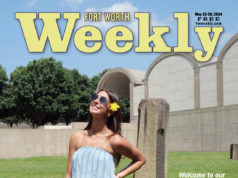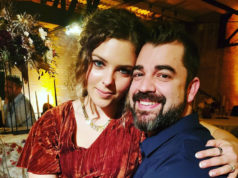I always read with a little stack of Post-it Notes nearby.
I use them to mark interesting passages. (“Wha-?! Lauren’s gonna get a job at MTV?! What’s Heidi gonna do?!” “Wha-?! K-Fed’s gonna be a guest ‘actor’ on One Tree?! OMG!” “Wha-?! Britney’s driving again?! Who gave her back her license – Judge Ito?!”)
About a hundred Post-its typically lasts me a couple of days. But after about 10 minutes and a third of the way through 30 Years: Interviews and Outtakes, by Michael Auping, chief curator of the Modern Art Museum of Fort Worth, I had to start tearing the little sticky sheets into thirds and then fifths to keep from running out before I finished all 288 pages of the softbound edition. At one point, there were about as many yellow flags popping out of the pages as there were pages themselves, and my stash had completely run out, which, actually, was just fine by me. No matter which page I open to now, I’m sure I’m going to come across something good.
The book, a succession of Q&As between Auping and 34 contemporary artists, is packed with stimulating – and quotable – material. Most of it comes from the mouths of the artists but seemingly just as often from Auping himself. The curator came to Fort Worth several years ago after stops in California, Florida, and New York state. A native Southern Californian, he spent the 1970s and early ’80s, earning his degrees and, evidently, chatting up artists. 30 Years collects most of his formal sit-downs and tells you when and where they were conducted. The book also includes photographs from Auping’s personal collection and stock images. (Check out the pic of him and Jenny Holzer from 1990, before he went chrome-dome. Not to blow smoke up you-know-where, but he looks about 10 years younger now. Most bald guys do.) The interviews are just some of the hundreds Auping has done over the years as a curator and critic. A few of them were conducted in the course of researching and writing exhibition catalogs. In every case, he is well prepared, dropping names, references, and quotes to propel discussion.
The interviews are not comprehensive. Most revolve around a particular exhibit, work of art, or time in the artist’s life. A little more than half of Auping’s subjects have worked with the Modern, including Tadao Ando, Robert Bechtle, Jonathan Borofsky, Vernon Fisher, Ellsworth Kelly, Anselm Kiefer, Bruce Nauman, Martin Puryear, and Bill Viola. Aimed primarily at art students and young professional artists, 30 Years also serves as a philosophical tome of sorts. There’s as much here about art as about inspiration, society, friends and enemies, and life in general. Some of his best subjects are Ando, Georg Baselitz, Bechtle, Jenny Holzer, and Puryear, not only because they’re erudite but also because they’re entirely plainspoken and clear-eyed about their ideas. They and Auping don’t have to fight to keep the artspeak at a minimum. It seems to happen naturally.
A point of departure for Auping’s convo with Holzer is “Money Creates Taste,” a piece she had installed in 1986 on the double-sided electronic signboard at, of all places, Caesars Palace in Las Vegas. In the discussion, which took place in snippets from 1989 through 1991, Auping gets immediately to the heart of the artist’s Truisms, the name of a series of declarative, publicly placed verbal artworks that she began in the 1980s and of which “Money Creates Taste” was part. “I was suspicious of narrative just because it seemed like something ‘old,'” she says. “I’ve changed my mind about that now, but … I wanted to write so that I could be very direct. I could say exactly what I wanted on any subject, and I could address specific topics. This is impossible to do with abstract painting,” the lingua franca of Modern art.
Asked why she didn’t get into a traditional form of writing, Holzer says, “It was a process of elimination. I knew the Truisms weren’t poetry, so they shouldn’t go into a little book, and I knew they weren’t a novel, so they didn’t need to go into a big book. I had to think of a form that was appropriate for them.” Auping seems as willing to collaborate with his subjects as he is to interrogate them. He and Ando, for instance, create one of the most elegant deDELETEions of architecture you may ever read. The curator starts by quoting legendary Modernist Le Corbusier about architecture’s being the ultimate form of social sculpture, and Ando takes it from there. Architectural forms, the Pritzker Prize-winning Japanese architect says, affect and are affected by people’s relationships to one another and the world around them. The challenge is protecting people while “creating an environment that brings them together as a society.”
Auping doesn’t chew the scenery. He’s an incredibly gracious and patient interviewer, and he shares their desperate passion to not be misunderstood. Which is not to say that some subjects don’t defeat him. Some are just Chatty Cathies (Ian Burn, Cai Guo-Qiang, Fort Worth’s Fisher). Some seem a little uncomfortable talking about themselves or just plain confrontational (Bechtle, Morton Feldman, Michelangelo Pistoletto), and some are just … out there. When asked about the name of an exhibition he had at the Modern, Keifer says, “The title Heaven and Earth is a paradox because heaven and earth don’t exist anymore. The earth is round. The cosmos has no up and down. It is moving constantly.” Whoa-kay …
Published last June, 30 Years: Interviews and Outtakes is available either online at www.themodern.org or at the Modern bookstore.
Dark Star … Driveth?
I never realized the power of ads on vehicles until I got stuck behind a white pickup truck on North Main Street the other day. The truck’s back window read “Dark Star Arise” and beneath “www.publishamerica.com.” Naturally, as soon as I got to work, I looked up Publish America, a sort of vanity press, and did a search for Dark Star Arise. Lo and behold, up came the name of the author, Eric Sproull, a local entertainer possibly operating under a pseudonym. “Dark Star Arise” is a book published in 2005, and it’s about, well, a “power-mad, corrupt Earth Emperor” struggling to “maintain control over his thousand-star system Empire when he learns of the Gold Dragon Pirate Clan’s intention to overthrow him. The Pirates ally themselves with a race of Reptiles who enjoy the taste of human flesh; and, together, the fragile Alliance opens the door to an invasion of human space” and you can guess the rest. I can’t say whether or not Dark Star Arise is any good, but you know I’ll be looking into it.
Public Art … and You
To continue the conversation about Fort Worth public art that we glommed onto about a week ago (“Arting Up,” April 23, 2008), note that there’s a meeting coming up you might want to check out. Next Monday, the 19th, at 10 a.m., a panel will select an artist for the Texas & Pacific Railway Terminal project, a small but significant work that will commemorate the “Colored Waiting Room,” an area set aside during segregation for African-Americans. The meeting is at the Fort Worth Community Arts Center, 1300 Gendy St. For more information, visit www.fwcac.org.
Contact Kultur at kultur@fwweekly.com.
30 Years: Interviews and Outtakes
by Michael Auping
Published by the Modern Art Museum of Fort Worth with Prestel
$23.95
288 pps. (softbound)











